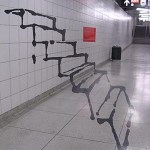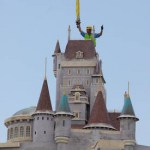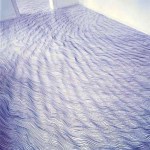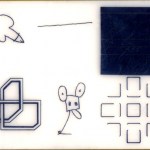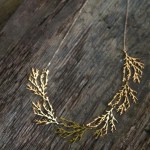Art
What better way for a bunch of science geeks to celebrate a birthday than by having a science party? We spent a lot of time making delicious science-themed snacks, and I have to say, they came out pretty good!
Bacterial jello plates. They looked a bit too relastic, the cell biologists wouldn't touch them.
More plates, this time made with rice pudding. Tastier than jello, but less popular due to looks.
DIY electrophoresis jello. The red dye didn't migrate, but the yellow colouring of the jello did!
Obligatory placebo gag.
The text reads sample:alcohol 1:2. It didn't lie.
Señor…
[More about photography, children, childpornography, pornography, porn; fotografi, barn, pornografi, porr, barnporr, barnpornografi.]
In issue 2011:1 of Fotografisk Tidskrift, the journal of the Swedish Photographer's Association, is a fine essay in Swedish by Jens Liljestrand (Twitter @jensliljestrand) about current attitudes to images of children and the definition of child pornography. Before the piece could be printed with the accompanying photographs, the journal's editor, my friend Jenny Morelli, had to clear its contents with the rights holders, who don't know Swedish. So she asked me…
Two videos that Patrick Boyle and I made were selected for the Bio:Fiction Film Festival! One of the prizes is an online audience award, and you can watch and rate all of the films! It's such an honor to be part of this festival and to be showing our work next to that of so many amazing artists, scientists, and filmmakers, and we would be super thrilled if you voted for us!
Here are our videos! First, the world premiere of Compound 74, a fictional documentary about a possible future of synthetic drug design through synthetic biology:
And second, the commercial we made for Ginkgo BioWorks--…
Or forced perspective.
I suspect this is more sensitive to viewpoint than the previous post.
-via BoingBoing-
These installations (or more precisely drawings on the floor and ceiling) take advantage of our use of textures to perceive a third dimension/depth out of monocular cues. I'm curious how effective they are from different viewpoints. Perhaps there are some accidental views that make the texture completely boring instead of completely cool.
Here's some great examples:
Check out bookofjoe for some more examples.
-Via Neatorama-
The destruction of the Buddhas of Bamiyan by the Taliban was a clear example of the destructive power of religious intolerance — it takes a religious mind to turn the demolition of art into a virtue. Now we have another example of extremism attacking art: Catholic fundamentalists in France have destroyed Andres Serrano's Piss Christ.
On Saturday, around 1,000 Christian protesters marched through Avignon to the gallery. The protest group included a regional councillor for the extreme-right Front National, which recently scored well in the Vaucluse area in local elections. The gallery…
My dynamic colleague Bengt Nordqvist, for whose project I volunteered a few days in the summer of 2009, believes that contacts of his have found two Classical figurines of Venus (above) in the Gothenburg area. It looks like a fun possible case of misidentification. I don't know Classical Mediterranean sculpture, and I don't know neo-Classical 17th century sculpture either, so I can't really comment except to say that the bearded praying guy below definitely looks post-Reformation to me. But here's what my correspondent John Kvanli tells me (and I translate).
Us in Rygene Detektorklubb have…
This is the first in a series of posts about art, the moon, and art on the moon. You would think this would be a fairly limited subject, but...
Art on the moon has been happening for a long time.
In 1969, a coterie of American contemporary artists devised a plan to put an art museum on the Moon. When NASA's official channels proved too dauntingly bureaucratic, Andy Warhol, Robert Rauschenberg, David Novros, Forrest "Frosty" Myers, Claes Oldenburg, and John Chamberlain weren't deterred. Instead, they managed to sneak their "museum" -- in reality a minuscule enamel wafer inscribed with six…
Most people are at a loss to be able to identify any useful connections between arts and
sciences. This ignorance is appalling. Arts provide innovations through analogies, models, skills,
structures, techniques, methods, and knowledge. Arts don't just prettify science or make technology
more aesthetic; they often make both possible.
That cell phone or PDA you're carrying? It uses a form of encryption called frequency hopping to
ensure your messages can't easily be intercepted. Frequency hopping was invented by the composer
George Antheil in collaboration with the actress Hedy Lamarr. Yeah,…
I had the pleasure of meeting recreational mathemusician (think about the implications) Vi Hart today at the "Thinking Creatively" conference on our campus. Watch this brilliant video (shown during her seminar) and learn mathematics like never before.
Vi's audience included not only design students and professionals, but a cohort of students preparing to become mathematics teachers. Her work is a beautiful example of bridging art, play, music and mathematics and, yes, pedagogy - the study of teaching and learning and how to connect with students. You can follow her videos here.
Bravo,…
Touching down at Minneapolis airport shortly before 19:00 last night, my wife and I were met by the charming Heather Flowers and Erin Emmerich from the Anthro Dept. They got us installed at our hotel and joined us for dinner at the food court of the monstrous Mall of America. (There's a theme park inside it.) Then to bed.
This morning we negotiated the ample, varied and sugar-rich breakfast buffet here at the Fairfield Inn, and then went to the light rail station. We're in the second-generation periphery of Minneapolis near the airport, outside the old industrial fringe. The roads are 6-lane…
Perhaps you have noticed that I haven't been blogging very much lately. Probably not, which is why I don't ever do these "sorry for not posting" posts, but I'm making an exception this time because it is a very special occasion. So, apologies for my recent lack of posts, but I got married last weekend! Of course, my wedding was not without biologically inspired design appropriate for mention on this blog. On my special day I wore Nervous System's algae inspired Filament Necklace.
Nervous System is a small and awesome company that combines background in biology, architecture, math, and…
Within certain education and policy circles the acronym STEM (i.e., science, technology, engineering, math) has become a common term, used frequently to be inclusive when referring to a broad area of scholarship and enterprise we deem particularly connected, i.e., those listed four subjects. How, or even whether the acronym is understood and fashionable outside these education "insider" groups is not well know. What is known, though, is that the acronym and associated term is not well defined even within groups that make heavy use of it.
When we say STEM, do we simply mean any of the four…
The chair of the Theatre Dept. here at LSU and I have begun co-producing a new "SciArt Conversation Series" here at LSU -- where we get scientists and artists on stage together at the same time for informal presentations of their work. We are trying to pick combinations that have some sort of real or semantic overlap. Our first one, which we just called "Silk", had an entomologist talking about the evolution of spiders and spider silk along with a choreographer and two dancers demonstrating and explaining dance moves on hanging silks.
This first one had a small but very vocal and…
Have you recently assessed how your students relate to science? I clearly remember when I was young watching old movies and television shows that depicted scientists as older men with glasses, crazy white hair, and lab coats. Have today's students' images of science changed? What about artists? Do they all have mustaches and paint on white canvases? These questions arose for me and my colleagues when working with upper elementary students on science, art, and literacy integration. When asked fourth grade students to illustrate and articulate their understanding of science and art, the results…
The Art of Science Learning is an NSF-funded exploration of how the arts can strengthen STEM skills and spark creativity in the 21st-Century American workforce. The project will be launched this spring with conferences in Washington, DC (at the Smithsonian's National Museum of American History, April 6-7), Chicago (Illinois Institute of Technology, May 16-17) and San Diego (CALIT2 at UCSD, June 14-15).
These conferences will bring together scientists, artists, educators, museum professionals, business leaders, researchers and policymakers, to explore the role of the arts in science education…
The Art of Science Learning is an NSF-funded exploration of how the arts can strengthen STEM skills and spark creativity in the 21st-Century American workforce. The project will be launched this spring with conferences in Washington, DC (at the Smithsonian's National Museum of American History, April 6-7), Chicago (Illinois Institute of Technology, May 16-17) and San Diego (CALIT2 at UCSD, June 14-15).
These conferences will bring together scientists, artists, educators, museum professionals, business leaders, researchers and policymakers, to explore the role of the arts in science education…
A major focus of The Art of Science Learning project is about attracting more students into the sciences and helping these STEM students become more creative and imaginative as they participate in the workforce.
But we should remember this is not just about the "STEM students" and assisting our physicists and engineers become more creative. It's also about bringing "science literacy" to a broader public - so that we are all better informed about our world and can make smarter personal decisions about issues that intersect with, say, how our bodies work, whether biofuels are good for the…
I've shown samples of Spanish archaeopotter Pablo Zalama's Beaker Culture pieces before. Here are some new replica Roman lamps of his.
If only Swedish pottery had been this good prior to the High Middle Ages! OK, the burnished ware of Ãland and Gotland in the Early Roman Period is good. And some of the stamped ware of Gotland's Migration Period isn't bad either. But when I read Thomas Eriksson's recent & solid PhD thesis on our Bronze Age and Earliest Iron Age pottery, I almost wept at how ugly and poorly fired the stuff is.
